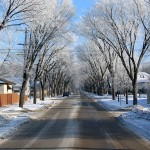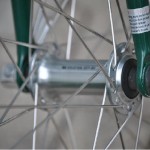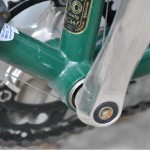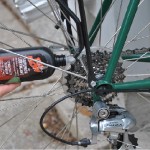Here are a few things you can do to get whatever “vehicle” you use ready for winter. Whether you ride your reindeer (see our post on Santa’s emissions as to why you might want to switch to a reindeer) or simply walk, ride, or drive, you’ll want to stay warm, dry, and efficient!
Walking

Photo: Green Action Centre
As winter approaches, the layers come out – hat, mitts, scarf, insulated coats, and warm, waterproof boots. The right clothing makes walking viable all year round.
When choosing winter footwear, it is great to have boots with good, rubberized tread and a waterproof lower section to keep the slush out. Lightweight is also a bonus, as some boots are heavy and make walking in deep snow a real workout. When buying boots, remember to wear the socks you’ll be using for winter which are often slightly heavier.
One excellent wardrobe addition is the slip-on shoe grips for walking on ice, (such as Yaktrax or Grips). Preparing for cold weather travel will help you enjoy the walk – whether you are walking to the bus stop, the store, taking the dog for a walk, or just out for a stroll.
Busing
If you are already riding the bus, not much will change except for the clothing needed to get you to and from the bus stop. (see above). However if you are changing transportation modes to the bus for the winter there are a few items to consider:
- Check the bus schedule, it may have changed since the last time you used it.
- You can learn about the newer features of the on-line Transit website including the award-winning Navigo route planner and the BusTXT system for your mobile device.
Cycling
Preparing for winter riding is about route planning, choosing the right clothing, and making sure your bike is ready to go. Doing a little maintenance on that bike will ensure that your ride is worry free.

Photo: Green Action Centre

Photo: Green Action Centre
Give your bike a good once over making sure that areas such as wheel hubs (left) and the bottom bracket (right) which contain bearings are running smoothly and are tight (no play in the bearings). This will reduce the amount of moisture, etc. that can enter these areas and corrode the internal parts. You may have to consider cleaning and repacking these areas with fresh grease at some point depending on how much you ride and when they were last maintained. Not sure how to do this? You can likely get some help at The WRENCH, The Bike Dump, the Bike Lab (U of W) or one of the other community bike shops around Winnipeg. You might even find that one of these bike shops is holding a workshop on very thing that you want to learn.
Check your tires to make sure they are in good shape. If you are looking at replacing your tires you may want to consider studded tires. They are not absolutely needed, however many winter riders use a studded tire on the front wheel to improve traction and steering control.
You may want to consider removing the derailleurs from your bike and converting it to a single speed. In winter derailleurs can quickly become clogged or seized and will require constant care and lubrication.

Make sure that you have lots of lubricant for your chain and other moving components. Remember that light bicycle specific lubricants work best in colder temperatures. If you don’t already have fenders you may want to consider installing a set for those wet and sloppy days.
Winter riding means often riding in the dark, so check that your lights (you should have both front and rear LED lights) are working properly and that the batteries are OK. Rechargeable batteries work very well and you can keep them topped up to ensure that your lights are always at their brightest. You may also want to consider getting an extra set of batteries to carry with you in case yours run out of power. As well. make sure to add a rear reflector and/or some reflective tape to your bike just in case your batteries die or your bike light doesn’t work.
For more information on riding through the winter check out this link.
Driving
If you want your car to run efficiently all winter, of course a trip to your friendly mechanic is always a good approach, however there are also a few simple things that you can do yourself make sure your car is ready for the cold.

Check your tire pressure! Seasonal temperature variations can have a significant effect on tire pressure. As temperatures drop so will your tire pressure and with it your fuel economy. Want to know more?
Traction is important and the you don’t want to be slipping and sliding all over the road. Check your tires for uneven wear which can be a sign of either unbalanced or misaligned wheels, either of which can be a serious safety issue. Want to know more?
Check your air filter! After a summer of driving (especially if you drive on unpaved roads) your air filter can become clogged. Why wait and have to check/change it when it is 30 below? A clogged air filter will effect you car’s performance and cost you at the gas pump too! Want to know more?
Check your antifreeze! If the concentration of the antifreeze is not sufficient it could result in significant damage to your engine. In addition, the cooling system of your car keeps the engine running at optimal temperature. If your car is running outside of this range, it will result in increased fuel consumption and potential engine wear. Want to know more?
For some other winter driving tips, check out this link.




Recent Comments